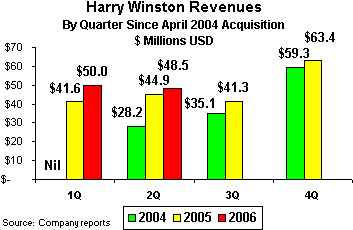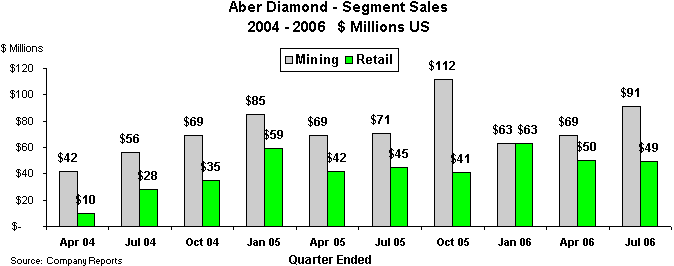IDEX Online Research: Harry Winston Expansion Continues
September 19, 06
Luxury retail jeweler Harry Winston posted a solid 8 percent sales gain in the three-month period ended July 2006, somewhat ahead of the 7.5 percent gain for the U.S. market, and above the overall jewelry sales gain globally, estimated to be up 5-6 percent in the period.
In addition to a solid sales gain, the luxury chain opened one new unit and announced several other planned store openings.
Finally, while operating margins shrank, it was due to unusual costs in the quarter. Underlying fundamentals driving margins were very strong, and are expected to generate an improved gross margin, operating margin, and pretax margin in the coming quarters.
The following graph summarizes sales for Harry Winston for the past three years, by quarter.

Highlights from second quarter results of Harry Winston, a division of Aber Diamond Corporation, are as follows:
- U.S. market strengthening – Harry Winston management noted that the broader diamond market in the U.S. showed signs of recovering from the softness of the first quarter of 2006. Globally, Harry Winston reported that the luxury goods segment of the retail jewelry industry, especially high-end diamonds and watches, generated solid sales gains.
- New store openings accelerate – In July, Harry Winston opened its first salon in London on Old Bond Street, a shopping Mecca filled with luxury flagship stores. In the fourth quarter of this year, a new salon is slated to open in Dallas, Texas. Other planned locations for Harry Winston stores include Chicago, Illinois; a dedicated watch salon in Tokyo; a relocated and larger store is Osaka, Japan; and a new store in Beijing, China.
- New stores fuel sales – Management noted that its new stores in Bal Harbour, Florida; Honolulu, Hawaii; and Tokyo, Japan, performed well.
- New jewelry introductions to boost demand – In July, Harry Winston introduced new jewelry collections which should help fuel sales during the all-important holiday selling season. The collections, Garland and Vine, are diamond-intensive, innovative in the use of different diamond shapes in very lightweight settings; and, most important, have lots of diamonds because they are recognizable from a distance. These collections will be offered with a full range of pieces at traditional Harry Winston price points up to $300,000 and beyond. Pieces in more modestly priced categories – with an entry price point of $7,000 – include simple necklaces, rings, pendants, and earrings.
- Custom jewelry demand solid – Management noted that its “bespoke” custom jewelry business in its European stores performed well, despite a normal summer seasonal slowness. In addition, management noted that its custom jewelry business in the U.S. was also reasonably strong. However, in both markets, it is difficult to predict demand for custom jewelry, since their customers specify when they want to take delivery of the jewelry.
- Underlying gross margin up – Harry Winston’s reported gross margin was flat at 48 percent in the quarter, but the underlying fundamentals suggest that it will rise – perhaps sharply – in the future. The gross margin in the quarter was negatively affected by the sale of certain inventory that was on hand at the date of the acquisition of Harry Winston in the first quarter of 2004; this inventory was sold at a lower margin than normal. We think it is time to get rid of the pre-acquisition jewelry, especially since the merchandise had been in inventory for more than two years, suggesting an annual inventory turn of less that 0.5x. After eliminating the negative impact of this pre-acquisition inventory, Harry Winston’s gross margin in the quarter would have been about 51 percent, a full 300 basis points higher than last year. The underlying gross margin improvement was due to two key factors:
- Increased sales of higher-margin product, including both jewelry and watches.
- Synergies related to its parent company, Aber Diamond, to source diamonds.
- Operating costs up – Since the new London salon opened in July, just as the quarter was ending, the company took heavy store opening costs in the period, but did not benefit from sales absorption of those costs. Corporate retail divisional operating costs were $22.8 million in the quarter, up from last year’s $18.7 million. Roughly 90 percent of the $4.1 million increase in expenses in the quarter was related to the new London store. Those store opening expenses included the following: salaries and benefits +$1.5 million; advertising and selling expenses +$1.0 million; rent and building related expenses +$0.8 million; and other expenses including professional fees of +$0.8 million.
- Retail sales mix decreased – In the quarter, Harry Winston revenues represented about 35 percent of Aber’s revenues, down from 39 percent last year. This was due to a 28 percent increase in rough diamond sales to $91 million in the second quarter.
- Overseas sales stronger – Harry Winston sales in its U.S. stores were down 5 percent in the quarter, but were solidly ahead by 18 percent in both Europe and Asia, versus the same three-month period last year.
Rough Diamond Business Strong
Aber Diamond’s management was very bullish on its rough diamond operations, as their comments below reflect:
- Processing capacity up – At the Diavik mine, which Aber and Rio Tinto operate jointly, processing plant throughput has increased from an initial capacity of 1.5 million tons a year to a projected 2.3 million ton capacity on a going-forward basis.
- Fifteen-year life expected from new mine – The Diavik project is evaluating the feasibility of a new mine which will combine underground and open pit production; this mine has a projected life of 15 years or more.
- New mining method evaluation continues – A new mining method which will use mechanical technology for the underground mine is being evaluated. Instead of the conventional drill-and-blast technique, the new mining method will improve production rates and reduce diamond damage from blasting.
- High-end diamond market stable – Aber produces generally better quality diamonds, and management says demand in its market niche was stable in the second quarter. Two diamond sales and one diamond tender were conducted in the three-month period. The open market tender helped the company test its diamond pricing structure. As a result of the tender, Aber increased prices for its highest quality diamonds, but reduced prices for its lower-quality stones. These trends are consistent with global retail trends, where demand for high quality stones remains robust.
- Long term outlook: retail demand solid, but supply questionable – Aber’s management said that its “longer term view is that the retail sales [of diamonds will] remain sound, [but] world diamond production is actually expected to decline rather than increase over the next five to 10 years.”
The following graph illustrates historical sales by segment for Aber Diamond.
 |